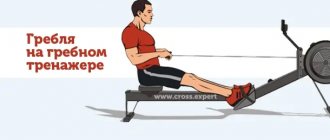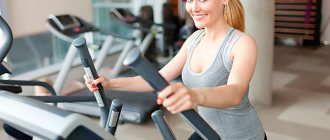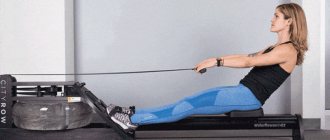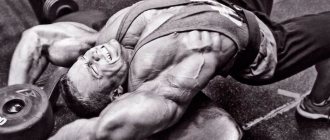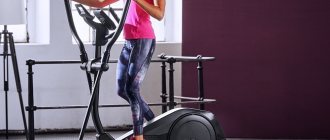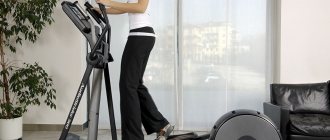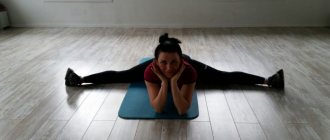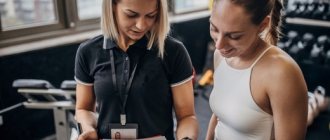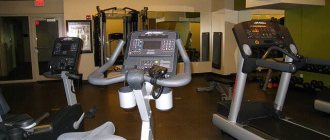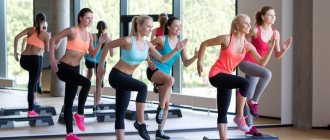Share:
What you need
- Rowing machine
Rowing is an effective and popular exercise in CrossFit. A rowing machine is used to simulate the work of a rower in a boat, but only in a gym environment. At the same time, a fairly high cardiovascular load is placed on the body - it’s not for nothing that rowing is included in the group of so-called cardio exercises. Today we will tell you about which muscles are involved when rowing, about the harms and benefits of rowing, and we will also tell you in detail how to properly exercise on a rowing machine.
What are the benefits of using a rowing machine?
Helps you lose weight without harming your joints
Rowing burns Calories burned in 30 minutes for people of three different weights about 210 kcal for 30 minutes of work at an average pace (for a person weighing 60 kg) - the same as exercise on an exercise bike. Or even moreA comparison of energy expenditure during rowing and cycling ergometry. In one and a half months of training on a rowing machine, you can lose about 1 kg of fat and build 600 g of muscle without any diets.
Running burns more calories, but it also puts stress on your leg joints, which can be a problem for people who are older, have bad knees, or are overweight.
During rowing, there is no shock load, and the body weight is supported by the simulator itself. Therefore, this type of cardio is perfect for people of any age and weight.
Harmoniously develops the muscles of the whole body
Unlike running or cycling, in which the legs work much more than the arms, rowing harmoniously pumps both the upper and lower body.
In one whole stroke, the biceps and triceps, the deltoid muscles covering the shoulder joint, and the core muscles - the abs and back extensors, trapezius and latissimus dorsi - manage to work. As well as hip flexors, quadriceps and hamstring muscles, buttocks, foot flexors and extensors.
In one study, Comparative analysis of basal physical fitness and muscle function in relation to muscle balance pattern using rowing machines, 8 weeks of rowing increased torque (force x distance) in participants' elbows, shoulders, lower back, and knees by more than 30%.
In another experiment, one and a half weeks of classes increased the strength of the back muscles by 10.7%, and the strength of trunk flexion (abdominal muscles) by 36.4%.
Increases stamina
Like any cardiovascular exercise, rowing develops overall endurance and improves Cardiovascular Effects and Benefits of Exercise, The Benefits of a Rowing Machine cardiovascular health. As a result of such training, you will be able to work at an energetic pace for longer, and everyday tasks will no longer cause shortness of breath and fatigue.
Helps correct posture
Rowing strengthens the back muscles and requires symmetrical, perfectly balanced movement of all muscles in the body, which can lead to improved posture over time. Thus, in one study, Effects of Indoor Rowing Exercise on the Body Composition and the Scoliosis of Visually Impaired People: A Preliminary Study, six weeks of training on a rowing machine five times a week reduced the Cobb angle for scoliosis by 1.1°.
What muscles work?
Rowing on a rowing machine is universal in nature, that is, it is suitable for people with different athletic training and different body types.
In particular, such classes are recommended for people with medical restrictions in sports, as well as those who are very overweight. A sitting position during training ensures the safety of the knee and hip joints when the athlete is heavy.
When the technique is performed accurately, the rowing machine pumps the following muscle groups throughout the body:
- arms: wrist extensors and flexors, triceps, biceps;
- shoulders: front and rear deltas;
- back: vertebral columns, trapezius muscle, latissimus dorsi;
- legs and buttocks: hamstrings, gluteus maximus, quadriceps;
- abs: internal and external oblique muscles.
Additional load falls on the pectoral muscle.
The main feature of rowing using a rowing machine is the simultaneous activity of a large number of different muscles of the body. Intense work of the body increases the number of heart contractions, which creates an incomparable cardio effect during the training process.
How to use a rowing machine correctly
Sit on the rowing machine, place your feet on the platforms and secure the straps so that they are located above the laces of your sneakers. You can adjust the special insert to fit your foot size.
Grab the handle of the exercise machine shoulder-width apart, bend your knees and roll the seat closer to your feet. Place your shins vertically, tilt your body forward so that your shoulders are in front of your hips, and straighten and relax your arms. This phase is called capture.
Next, the stroke or thrust phase begins. Press your heels into the stand and push the machine with your legs, straightening your knees and at the same time slightly extending your back. Do not strain your hands - in the first phase of the movement they simply hold the handle.
Footwork accounts for 70% of the power of your stroke, so try to push off strongly without using your arms or back. At the same time, keep your body rigid and tense, do not relax your back.
When the handle crosses your knees, bend your arms and powerfully pull it towards your body, bending slightly back. At the extreme point, your forearms should be parallel to the floor, your legs should be fully straightened. This phase is called the end of the stroke, or exit.
Next, the recovery or return phase begins. Fully extend your arms and slightly tilt your body forward, bending at the hip joint. Then bend your knees and slide forward, shifting your weight from your heels to your toes and maintaining the position of your arms and body until you are in the starting position.
Continue rowing without pause at the extreme points. Try to make the movement smooth and continuous.
Where to study?
A rowing machine is commonly found in all gyms, but you can also purchase one for use at home. If you're looking for home workout equipment but don't have much space, a rowing machine may be the perfect option. It is relatively lightweight and does not take up as much space as other fitness equipment. You can choose an option in both the high and low price segments. Often, a rowing machine is even cheaper than a treadmill or bicycle.
What mistakes should you avoid when using a rowing machine?
Poor rowing technique causes you to overexert yourself, prevents you from making a powerful stroke, and increases your risk of injury. We will list the main mistakes common to most beginners.
Bend your knees until your arms straighten
At the end of the stroke, you must first straighten your arms and only then bend your knees. If you break this sequence, you will have to throw your hands over your bent knees, which will simply break your movement.
Rowing with bent arms
In the first phase of the movement, the arms are completely straightened and relaxed. If you start the stroke with your arms bent and keep them tense, your biceps will quickly fatigue and the stroke will not be nearly as powerful as if you were using your legs.
Rowing with bent wrists
Bending your wrists increases the stress on your joints and increases your risk of injury. Keep your arms relaxed and make sure your hands are in line with your forearms, without creases or bends.
Elbow extension to the sides
If you lift your shoulders and push your elbows out to the sides, your body is doing extra work that needlessly fatigues your back and shoulder muscles without providing any benefit.
Make sure that your shoulders are not pulled towards your ears, and that your elbows are located closer to your body and extend beyond the body line at the end of the stroke.
Too much body extension
If you lean back too much during the recovery phase, it will take a lot of force to bring your body back to a straight position. The energy consumption for such a return exceeds the benefits of an extended stroke.
Extending your legs too quickly
You straighten your legs and move back, but at the same time leave the handle in front and only then work with your back. With such an error, part of the energy from the kick is wasted. Make sure that your body and arms do not remain in front, but accompany the movement with your legs.
Premature back engagement
If you lean your body back too early, your back extensors take some of the work away from your legs. As a result, the load on the lower back increases and rowing efficiency decreases. So push off with your legs first and only then engage your back.
Strong forward lean
If you bend your back too much during the catch phase, so that your stomach rests on your hips and your shoulders extend beyond the line of your knees, the lower back muscles become stretched and lose tension. Subsequent sudden extension may result in injury. Make sure that your shoulders do not go beyond your knees, and that your back is always “charged.”
Rowing machine design[edit | edit code]
Example of rowing machine instructions in Russian: Concept2 Rowing Machine User's Guide
Classification[edit | edit code]
Air, Water and Magnetic Rowing Machines
There are 3 types of rowing machines available in the market today.
Air rowing machine
– often compared to an exercise bike; These machines use resistance created by air. The air movement is created by the built-in fan blades, which in turn drive the flywheel. The resistance may vary depending on the traction force. Currently, the most popular rowing machine of this type is the Concept 2. Its cost in online stores averages 70 thousand rubles.
Water rowing machine
– in rowing machines that operate on water resistance, the movement of a boat through the water is ideally simulated. If you ignore the sound of the water, these machines are virtually silent. A water simulator from Water Power, made of ash, costs about 70,000 rubles, a version made of steel costs about 100,000 rubles.
Magnetic rowing machine
– These soft and variable resistance machines are often used in gyms. Plus, they are virtually silent thanks to a magnetic braking system that produces no friction. The market offers a wide selection of magnetic trainers, among which a popular one is the Kettler Coach, the price of which is about 40 thousand rubles.
Basic elements of a rowing machine[edit | edit code]
Basic elements of a rowing machine
Frame design
– it is advisable to choose a solid metal structure with an aluminum seat base. Try to sit on the machine - no part of the frame should bend under the weight of your body.
Brake system
– Electronic rowing machines use magnetic braking, so they are almost silent to use, but are inferior in quality to air and water machines. Aerial trainers have very high motion quality and precision, but they can be noisier. Water simulators create the closest resemblance to real rowing on the water and also produce interesting sounds.
Transmission
– Choose chains or cables that provide a comfortable paddling feel without stretching or too little kickback when accelerating.
Quality of movement
– the movement should be smooth, without jerks or points of sudden decrease in resistance, especially at the beginning of the effort (a typical drawback of rope transmission). Check the range of motion: when you have moved forward as far as possible (i.e., so that your buttocks are as close to your heels as possible) with your arms fully extended and holding the rowing levers, the “oars” should not return to the starting position.
Ease of operation
– How clear and understandable is the information presented on the display? How easy is it to find access to the programs (if any)? Are the buttons clearly visible and how easy are they to use?
Comfortable seat
– you should feel comfortable on the seat, even after rowing several thousand meters!
Seat base and guide frame
– move the seat to one end of the frame and lift that end of the machine up a little – a good base and guide frame will allow the seat to move freely to the other end of the frame, even with a slight tilt.
Rowing lever handles
– is it comfortable enough to hold the “oars”? Will your grip remain strong even when your hands get tired and sweaty?
Possibility of adjusting the footrest
– check how comfortable and securely your feet are placed on the support.
General dimensions
– Rowing machines are typically one of the most compact pieces of home exercise equipment, but have a long and narrow base. Some can be stored vertically, which is convenient if you don't have enough space in your home.
Quality assurance
– Most home rowing machines are quite durable, but it is still a good idea to check what kind of warranty is offered on the frame, drivetrain and any electronics. Find out which service center will carry out repairs in the event of a breakdown.
How to deal with the “Menu” of the device[edit | edit code]
The menu of one of the most popular rowing machines
Using the menu, you can control the calories burned and the energy generated, but most rowers use the screen to control the time for completing a 500-meter course or a simple period of time. The number denoted by SPM
- number of strokes per minute. Generally, the length of time and stroke rate are inversely proportional, meaning that as the stroke rate increases, the length of time will decrease.
Load settings.
A very common mistake is the tendency to set the maximum load. This approach is not recommended, as it will lead to injury faster than high endurance results. For the maximum load, take 75%, this will be enough to work on the correct body position, speed of movement when gripping and improve your performance. By choosing the wrong program, you will rely on the machine as the only source of load.
“Split”
determines
how long it will take to cover a distance of 500 meters. For example, if you set the “split” to 1 minute 45 seconds, then you need to row with enough effort to cover 500 meters in that time.
Advantages and disadvantages of the simulator[edit | edit code]
Advantages
In terms of the number of muscles involved, rowing is second only to cross-country skiing, using more than 82% of the body's muscular system.
Most joints are used through a significant range of beneficial motion. In this case, the joints are not overloaded. This makes rowing one of the best forms of physical activity for people of any category:
- who wants to lose weight, gain muscle tone and train the cardiovascular system;
- who strives to become flexible, strong and resilient;
- competitive athletes;
- those recovering from injuries;
- people of any age.
Disadvantages of the simulator
- Large dimensions of the product
- Incorrect exercise technique leads to back injuries
What exercises can you do to establish technique?
Work only with hands and body
This exercise will help correct errors associated with hand work.
Fully straighten your legs, straighten your back and for a minute work only with your arms, pulling the handle towards your chest. Watch the position of your wrists, do not raise your shoulders or spread your elbows to the sides.
In the next minute, connect the case to work. Make sure that your back does not bend back too much and remains “charged”.
Working with pause
Another arm exercise that will teach you to take the correct position during the exit phase.
Complete the stroke and pause. Check the position of your elbows, shoulders and wrists, and the angle of your body. If you imagine your body as a clock hand, it should be at 11.
After a pause, straighten your arms, perform a return and a new stroke.
Pause before recovery phase
This movement will teach you to first straighten your arms and only then bend your knees.
Perform the stroke, then straighten your arms, tilt your body slightly and pause for 1-2 seconds. After this, end the recovery phase and take a new stroke. Repeat 10 times.
Movement with legs only
This exercise is useful for those who have difficulty feeling the movement of their legs and work mainly with their back and arms.
Straighten your arms, fix the position of your back and work only with your legs, pushing off and driving back up. Do 10 of these strokes.
The effectiveness of rowing for the development of spinal muscles
The mechanics of movement when performing rowing are similar to the deadlift, a basic exercise that many athletes consider the best for muscle development. Deadlifts allow you to build a powerful back and build impressive arms.
All professional rowers have a wide and muscular back, powerful and pumped up arms. Similar figure development can be achieved through regular exercise with a rowing machine. This becomes possible only with full compliance with the technique of performing rowing movements.
What to do if your back hurts from using a rowing machine
Since rowing puts a lot of stress on the back extensors, if you have problems with the lumbar spine, start the session carefully and monitor the sensations. Row for no more than 20 minutes without stopping, then take a break and do a few stretches.
Pulling your knees to your chest
Grasp your legs under your knees with your hands and pull them closer to your chest so that your pelvis lifts off the floor. Press your thighs toward your stomach and hold the position for 30 seconds. Then return your feet to the floor, rest a little and repeat two more times.
Kneeling back stretch
Get on all fours, place your knees under your hips and your palms under your shoulders. Then push your pelvis back and sit on your heels, lower your head. Spend 30 seconds in this position. Feel your back and shoulders stretch.
Abdominal stretch
Lie on your stomach, straighten your legs. Leaning on your hands, lift your chest off the mat and stretch the top of your head toward the ceiling. Don't lift your hips off the floor or lift your shoulders toward your ears. Feel how your stomach stretches. Spend 30 seconds in this position, lower your chest to the floor, rest a little and repeat two more times.
General recommendations
After fifteen minutes of exercise, you must take a break of 30 to 60 seconds, during which it is recommended not to rest, but to pump up your abs, do push-ups or squats with your own weight. If you practice without such pauses, your back will hurt.
People with spinal or back problems should use a rowing machine in the presence of a qualified trainer. The slightest deviation from the technique of execution, if there is no mentor nearby, can aggravate your well-being.
Gaining an athletic physique with a powerful, well-developed back and pumped-up strong arms can only be achieved by following all the recommendations for working with a rowing machine and strictly following the correct execution technique.
How to Use a Rowing Machine to Build Endurance
Below are two programs from coaches Terry O'Neill and Alex Skelton's great guide to indoor rowing:
- Basic conditioning is suitable for those who lead a sedentary lifestyle and have not been involved in sports or fitness for a long time. It will help you gradually adapt to the load and, in 8–12 weeks, bring your sessions to 30 minutes of continuous rowing.
- Rowing for 20 or 40 minutes is useful for those who have already mastered the technique, are looking to increase their performance and are ready to exercise regularly from 3 to 5 days a week.
Basic conditioning program
Throughout the program, you will work at 75% of your maximum heart rate (HRmax).
To calculate this indicator, use the formula: 220 - age = HRmax . For example, if you are 30 years old, HRmax would be 190 beats/min, and 75% of HRmax would be 142 beats/min.
If you don't track your heart rate with a wristband or chest strap, use your feel to work at a conversational pace. You can exceed it when you have the strength and desire.
Exercise regularly - 3-4 times a week with a rest day between workouts. Start with the first step and move on to the next only when the previous one is perceived comfortably:
- One minute of rowing, 30 seconds of rest - 5 laps . Each session, add one lap until you reach eight. Then move on to the next step.
- Two minutes of rowing, 30 seconds of rest - 5 laps . In the same way, add one circle at a time to eight.
- Three minutes of rowing, 30 seconds of rest - 5 laps . The same as in the first two steps.
- Four minutes of rowing, 30-60 seconds of rest - 4 laps . Gradually add one circle at a time until you reach seven.
- Five minutes of rowing, 30-60 seconds of rest - 4 laps . Increase to seven circles and move on to the next step.
- Increase continuous work time faster than in previous stages. For example, try doing 4 laps of 7.5 minutes of rowing with a short rest in between, then in your next workout, three laps of 10 minutes or two laps of 15 minutes. Once you reach 20 minutes of continuous rowing, start adding 2 minutes each session until you reach 30 minutes of rowing without a break.
Rowing for 20 or 40 minutes
This program lasts nine weeks and is divided into periods of preparation, development and strengthening. In each of them the load gradually increases.
The program is designed for training 3-5 days a week. If you're doing three sessions a week, do the first three workouts and then move on to the next week.
As for training time, choose a program based on your capabilities. In the files below you will find tables with a training schedule:
- Rowing program for 20 minutes →
- Rowing program for 40 minutes →
Rating of the best rowing machines[edit | edit code]
In the category of rowing machines, there are many models with different pricing policies, the average price varies from $100 to $1500. Below is a ranking of the best rowing machines for 2017, taking into account price and number of reviews. The selection was carried out independently of Russian suppliers of sports equipment, based on reviews and ratings from one of the world's largest Internet sites for the sale of goods and services.
Price range 50$ - 200$:
- Sunny Health and Fitness – $79 – 690 reviews
- Stamina Body Trac Glider 1050 – $110 – 2222 reviews
Price range 200$ - 300$:
- Stamina 1215 Orbital Rowing Machine with Free Motion Arms – $215 – 341 reviews
- Sunny Health & Fitness SF-RW5515 — $217 — 622 reviews
- Stamina ATS Air Rower – $299 – 794 reviews
Price range 300$ - 400$:
- Proform 440R Rower – $300 – 138 reviews
- Kettler Home Exercise – $399 – 132 reviews
Price range 400$ - 800$:
- Velocity Exercise Magnetic Rower – $507.8 – 185 reviews
- Stamina Avari Programmable Magnetic Exercise Rower – $699 – 112 reviews
- Stamina 15-9003 Deluxe Conversion II Recumbent - $799 - 92 reviews
Price range 900$ - 1300$:
- Concept2 Model D Indoor Rowing Machine with PM5 – $945 – 1500 reviews
- WaterRower Natural Rowing Machine in Ash Wood with S4 Monitor - $1160 - 224 reviews
- Concept2 Model E Indoor Rowing Machine with PM5 – $1160 – 198 reviews
- WaterRower Club Rowing Machine in Ash Wood with S4 Monitor – $1160 – 195 reviews
How to combine rowing with other exercises
You can include rowing with strength training and other forms of cardio.
Such workouts really burn a lot of calories, improve strength endurance and save time, but they are only suitable for healthy people who are not overweight and have some experience in rowing and strength training.
We will give several options from CrossFit.
Chipper with rowing
Perform in a row, without rest if possible:
- 50 air squats;
- 25 calories from rowing;
- 40 Russian kettlebell swings;
- 20 calories from rowing;
- 30 press folds;
- 15 calories from rowing;
- 20 push-ups;
- 10 calories from rowing;
- 10 burpees.
User opinions
The rowing machine has positive reviews. Users say that such equipment is incredibly useful for training the heart and maintaining muscle tone. Despite the fact that rowing is difficult, the effect is amazing.
The rowing machine allows you to build and lose excess weight. The last advantage is highly appreciated by women.
Rowing machine for health and beauty
A rowing machine allows you to lose excess weight, give your body definition and strengthen your heart and blood vessels.
Users also like the fact that they can exercise on the exercise machine even at home, the main thing is that there is a place in the apartment to install it.
Indications for use
Indications for use of the device:
- slouch;
- curvature of the spine of varying degrees;
- presence of osteochondrosis;
- disc compression between the vertebrae;
- decreased normal brain activity;
- indigestion;
- lack of perky breasts.
Sprints or extreme rowing
This variation is used to increase the cardio effect of the exercise. Sprints reduce the intensity of the resistance while increasing the speed of the row. This leads to more aerobic activity, which helps burn excess calories.
- In this exercise, you perform a regular rowing exercise, but the difference is that you do not return the handle all the way to the starting position.
- Increase your rowing speed, stopping in the “Snatch” position.
- Do as many repetitions as possible in 1 minute. To make the exercise more challenging, you can increase the time period and rowing speed.
Alternating between simple and extreme rowing
As a result of this alternation, you will increase your heart rate and warm up your muscles well before the main workout. It can also be used as a cool-down at the very end of a workout.
- Make a playlist of three songs (choose songs with a speed of 150-180 quadruple beats per minute).
- During the first track, perform simple rowing at a steady pace.
- During the second track, maintain an easy, steady tempo until the chorus, then switch to an extreme sprint until the end of the chorus. Repeat for each chorus and guitar solo, for rock fans, easing the tempo during the verse.
- Do the same during the third track. Don't forget: you can always rest where you need it. Take a break when the playlist ends.
